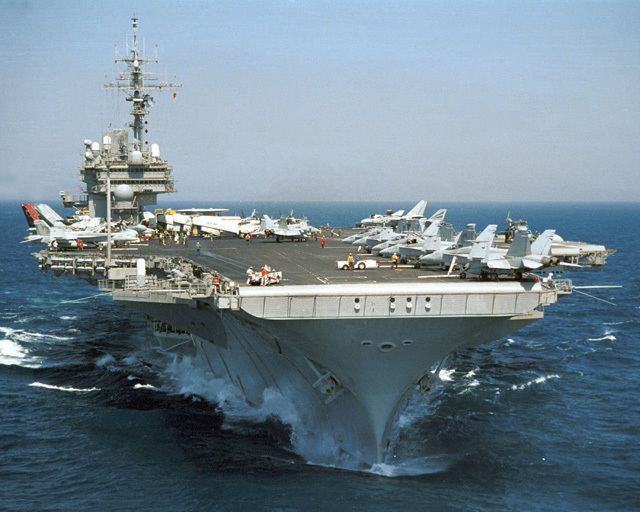Preceded by Forrestal class | Succeeded by Nimitz class | |
 | ||
Builders New York ShipbuildingNew York Navy YardNewport News Shipbuilding Subclasses John F. Kennedy class (variant) | ||
The Kitty Hawk-class supercarriers of the United States Navy were an incremental improvement on the Forrestal-class vessels. Three were built, all in the 1960s, Kitty Hawk (CV-63) (1961–2009), Constellation (CV-64) (1961–2003), America (CV-66) (1965–1996), as well as the variant John F. Kennedy (CV-67) (1967–2007). All are now decommissioned.
Contents
Improved Forrestal carriers
The biggest differences from the Forrestals are greater length, and a different placement of elevators; two are forward of the island, one is aft of the island and another on the portside stern. The movement of the #4 elevator from the forward to the after end of the angle made it useful for aircraft movement, since the forward-end elevator in the Forrestals was sited in both the landing path and in the launch path of the waist catapults.
Three different shipyards were used to construct the ships. Kitty Hawk was built at New York Shipbuilding Corporation, Constellation at New York Naval Shipyard, America and John F. Kennedy at Newport News Shipbuilding. John F. Kennedy is similar to the earlier units in flightdeck arrangement and propulsion, but has enough differences that she is placed in her own class. Propulsion consisted of four Westinghouse geared turbines, 280,000 shaft horsepower (210,000 kW), four shafts with eight 1,200 pounds per square inch (8,300 kPa) Foster Wheeler boilers.
Construction and design differences
The first three units were constructed with a Terrier surface-to-air missile system. The supporting missile launchers and AN/SPG-55 radars consumed a large amount of space, while at the same time duplicating the capabilities of the air defence escorts, and were later removed. John F. Kennedy did not have Terrier and was built with the shorter ranged Sea Sparrow, Basic Point Defense Missile System (BPDMS). All were eventually equipped with NATO Sea Sparrow (NSSM) and Phalanx CIWS for self-defense. In 2001, Kitty Hawk received two Rolling Airframe Missile launchers replacing the forward Sea Sparrow and Phalanx CIWS equipment. The SLQ-32 Electronic Warfare Suite was added as part of the Service Life Extension Program (SLEP) on Kitty Hawk and Constellation.
America had several differences from the lead units of the class. Instead of two forward anchors, one on each side, America had no starboard anchor and an additional anchor astern, a change made to accommodate the AN/SQS-23 sonar. America was the only post-World War II U.S. carrier to be built with sonar, though it was removed in the early 1980s. She also had a narrow smokestack compared to prior units.
John F. Kennedy class
John F. Kennedy was originally scheduled to be the fourth Kitty Hawk-class carrier, but because she received so many modifications during construction, she formed her own ship class and is often listed as a single-vessel class. Kennedy had similar design changes regarding the anchors to accommodate a sonar array, but the sonar was never installed. There were also plans to make her nuclear powered, but since Congress would not authorize it, Kennedy was constructed as a conventionally powered carrier. Her smokestack is also different and tilts outboard to send stack gas away from the flight deck. The angled end of the waist is also different from the other Kitty Hawks, bearing a closer resemblance to that of the Nimitz class. Kennedy is also 17 feet (5.2 m) shorter in length than the other Kitty Hawk-class carriers.
Decommissioning
From 1987 to 1991 Kitty Hawk was overhauled for $785 million under the Service Life Extension Program (SLEP) at Philadelphia Naval Shipyard. From 1990 to 1992, Constellation received her $800 million service life extension also in Philadelphia. The program was intended to add 15 years to the life of the ships. John F. Kennedy was not overhauled as part of SLEP. Instead, from 1993 to 1995, she received a $491 million overhaul. It was the final project of Philadelphia Naval Shipyard prior to its closing. America had been scheduled to be overhauled under the service life extension program after Constellation, but she was decommissioned 9 August 1996 instead, during a time of budget cuts after the Cold War. America was in very poor condition when she was decommissioned, and therefore despite her historical significance was not held as a donation asset. She was expended as a live-fire target and sunk on 14 May 2005.
Constellation was decommissioned 7 August 2003. John F. Kennedy was decommissioned on 23 March 2007. Only Kitty Hawk remained in service as of early 2008 and was replaced by USS George Washington as the forward-deployed carrier in Japan. Kitty Hawk returned to the United States after the turnover. She was decommissioned on 12 May 2009.
